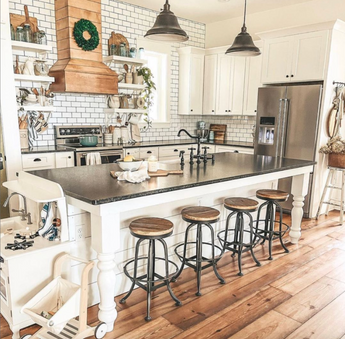Picking the Perfect Kitchen Island Leg for Durability and Functionality
The Importance of a Sturdy Cooking Area Island Leg in Creating a Useful Food Preparation Location
A durable kitchen area island leg acts as a fundamental component in establishing a practical cooking atmosphere, providing essential assistance for both the countertop and different kitchen area tasks. The stability it supplies can significantly decrease the danger of mishaps in high-traffic locations, while likewise contributing to the overall aesthetic comprehensibility of the area. As kitchens evolve into multifunctional areas for food preparation, eating, and mingling, the option of products and design factors to consider for island legs comes to be significantly essential. Understanding these aspects can transform your cooking area into a more secure and much more reliable area, prompting more exploration right into the best options offered.
Benefits of Sturdy Island Legs
Providing important support, strong kitchen island legs play a crucial duty in enhancing the performance and sturdiness of kitchen area islands - kitchen island leg. These legs not only bear the weight of the counter top and any extra items put on the island, however also add to the general security of the framework. A well-supported cooking area island makes sure that it remains functional and upright, even under hefty use, which is especially crucial in busy kitchen atmospheres
Furthermore, strong island legs can enhance the aesthetic allure of the kitchen area. They give a solid framework that can match numerous design styles, from contemporary to conventional. This convenience enables property owners to tailor their kitchen area islands according to individual preference while making sure that the architectural integrity continues to be uncompromised.
In enhancement to their supportive duty, robust cooking area island legs can also boost safety and security. Inevitably, spending in durable cooking area island legs is vital for a useful and aesthetically pleasing cooking location.
Materials for Cooking Area Island Legs
When selecting materials for kitchen island legs, sturdiness and aesthetic allure are essential aspects to consider,. The most common materials include wood, metal, and engineered wood, each offering one-of-a-kind benefits.
Hardwood, such as oak, cherry, or maple, is a timeless option due to its stamina and timeless charm (kitchen island leg). It can endure substantial weight and is resistant to put on, making it excellent for high-use kitchen atmospheres. Additionally, wood can be stained or repainted to complement numerous kitchen area designs
Metal legs, frequently crafted from stainless-steel or wrought iron, provide a industrial and modern appearance. They are exceptionally strong and can support considerable lots while being resistant to moisture and warm, which is useful in a cooking location. Metal legs can also be quickly cleaned up, enhancing their usefulness.

Layout Factors To Consider for Stability
The option of materials for kitchen island legs straight affects the style considerations for stability. When creating a cooking area island, it is extremely important to examine the weight-bearing ability of the picked materials. Larger materials, such as strong wood or steel, commonly offer greater security, particularly under the stress and anxiety of everyday use.
Furthermore, the leg style need to integrate appropriate geometry to improve stability. A bigger base increases the assistance area, decreasing the danger of wobbling or tipping. Consideration needs to likewise be offered to the elevation of the legs; disproportionate leg sizes can bring about inequality, endangering the total stability of the island.
Furthermore, the circulation of weight across the island is critical. Making sure that the leg placement aligns with the heaviest elements, such as countertops and home appliances, will better improve security.
Maintenance Tips for Longevity

Depending on the product of the legs-- whether timber, steel, or composite-- appropriate cleaning methods must be used. Steel legs may require a light polish to stop corrosion and maintain their appeal.
Additionally, tightening up bolts and screws routinely can ensure stability and prevent wobbling. Consider reinforcing the legs with extra braces or sustains to enhance resilience if the kitchen area island experiences hefty usage. Using a protective coating or sealant can secure against moisture and discolorations, extending the life expectancy of the legs. By following these upkeep pointers, homeowners can ensure their kitchen island legs continue to be durable and practical for years to come.
Picking the Right Leg Design
Normal maintenance guarantees that kitchen area island legs remain durable and practical, but picking the appropriate leg design is just as crucial for both aesthetics and assistance. The option of leg style can dramatically influence the overall style and consistency of your cooking area.

Capability is one more important element. Thicker legs or those with a durable base can support much heavier counter tops and devices, enhancing the island's energy. useful content Conversely, slim legs might develop a ventilated look, ideal for lighter designs but potentially much less supportive.
Final Thought
In summary, the significance of tough cooking area island legs can not be overstated in the creation of a functional cooking location. These legs give crucial assistance, enhance security, and add to the overall aesthetic of the cooking area.
A tough cooking area island leg offers as a basic part in establishing a functional cooking setting, giving needed support for both the counter top and different cooking area tasks.Offering crucial assistance, strong kitchen area island legs play a critical duty in boosting the capability and resilience of kitchen area islands. Ultimately, investing in durable kitchen area island legs is important for a functional and visually pleasing cooking location.
Factor to consider should additionally be provided to the elevation of the legs; out of proportion leg lengths can lead to inequality, jeopardizing the total security of the island.
Wood legs check out this site offer warmth and a timeless look, while steel legs supply a commercial and modern feel.